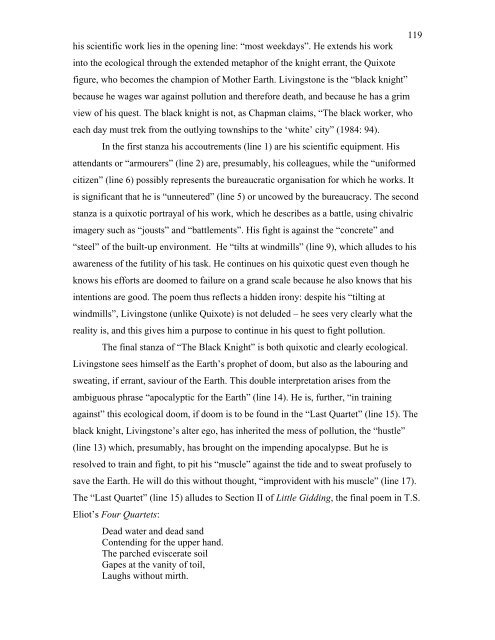"Symbiosis or Death": - Rhodes University
"Symbiosis or Death": - Rhodes University
"Symbiosis or Death": - Rhodes University
Create successful ePaper yourself
Turn your PDF publications into a flip-book with our unique Google optimized e-Paper software.
119<br />
his scientific w<strong>or</strong>k lies in the opening line: “most weekdays”. He extends his w<strong>or</strong>k<br />
into the ecological through the extended metaph<strong>or</strong> of the knight errant, the Quixote<br />
figure, who becomes the champion of Mother Earth. Livingstone is the “black knight”<br />
because he wages war against pollution and theref<strong>or</strong>e death, and because he has a grim<br />
view of his quest. The black knight is not, as Chapman claims, “The black w<strong>or</strong>ker, who<br />
each day must trek from the outlying townships to the ‘white’ city” (1984: 94).<br />
In the first stanza his accoutrements (line 1) are his scientific equipment. His<br />
attendants <strong>or</strong> “armourers” (line 2) are, presumably, his colleagues, while the “unif<strong>or</strong>med<br />
citizen” (line 6) possibly represents the bureaucratic <strong>or</strong>ganisation f<strong>or</strong> which he w<strong>or</strong>ks. It<br />
is significant that he is “unneutered” (line 5) <strong>or</strong> uncowed by the bureaucracy. The second<br />
stanza is a quixotic p<strong>or</strong>trayal of his w<strong>or</strong>k, which he describes as a battle, using chivalric<br />
imagery such as “jousts” and “battlements”. His fight is against the “concrete” and<br />
“steel” of the built-up environment. He “tilts at windmills” (line 9), which alludes to his<br />
awareness of the futility of his task. He continues on his quixotic quest even though he<br />
knows his eff<strong>or</strong>ts are doomed to failure on a grand scale because he also knows that his<br />
intentions are good. The poem thus reflects a hidden irony: despite his “tilting at<br />
windmills”, Livingstone (unlike Quixote) is not deluded – he sees very clearly what the<br />
reality is, and this gives him a purpose to continue in his quest to fight pollution.<br />
The final stanza of “The Black Knight” is both quixotic and clearly ecological.<br />
Livingstone sees himself as the Earth’s prophet of doom, but also as the labouring and<br />
sweating, if errant, saviour of the Earth. This double interpretation arises from the<br />
ambiguous phrase “apocalyptic f<strong>or</strong> the Earth” (line 14). He is, further, “in training<br />
against” this ecological doom, if doom is to be found in the “Last Quartet” (line 15). The<br />
black knight, Livingstone’s alter ego, has inherited the mess of pollution, the “hustle”<br />
(line 13) which, presumably, has brought on the impending apocalypse. But he is<br />
resolved to train and fight, to pit his “muscle” against the tide and to sweat profusely to<br />
save the Earth. He will do this without thought, “improvident with his muscle” (line 17).<br />
The “Last Quartet” (line 15) alludes to Section II of Little Gidding, the final poem in T.S.<br />
Eliot’s Four Quartets:<br />
Dead water and dead sand<br />
Contending f<strong>or</strong> the upper hand.<br />
The parched eviscerate soil<br />
Gapes at the vanity of toil,<br />
Laughs without mirth.

















